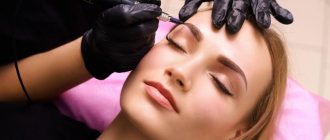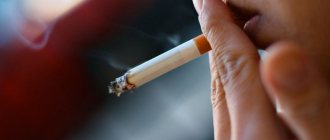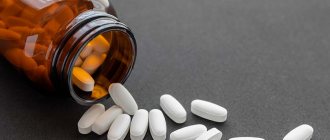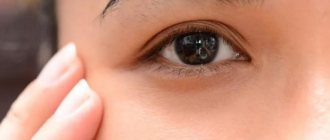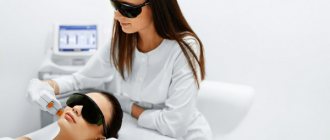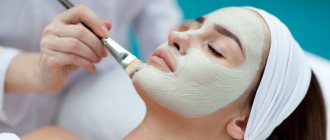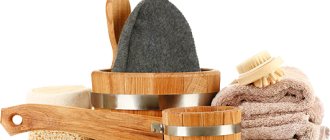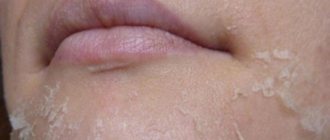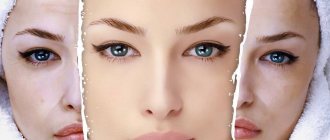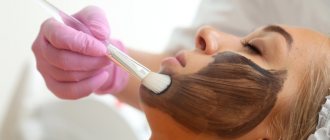Tanning is beautiful and fashionable. Ultraviolet baths received in small doses can give your face a uniform golden color. However, can this be done in cases where a peeling procedure has recently been performed?
Peeling itself is undoubtedly stressful for the skin. If we look at the problem more deeply, we can understand that it is a burn to the skin. The interaction occurs as a result of acid entering the epidermal cells. This is why doctors recommend refraining from sunbathing for a while.
Solarium and peeling: what goes into what?
Experts recommend performing deep or superficial peeling procedures after tanning, if it is obtained naturally - under the sun's rays, but for a solarium, different rules apply - first you need to perform peeling manipulations and after a certain time you can go for a “portion” of tanning.
This is due to the fact that “artificial” ultraviolet rays do not act aggressively on the skin; you can control your exposure to them and smoothly, gradually and safely intensify your tan.
Ultraviolet rays have ambiguous effects on the skin. On the one hand, tanning ensures stable production of vitamin D in the body, strengthens the immune system, and activates the renewal processes of epidermal cells.
On the other hand, it can provoke photoaging, when the skin becomes flabby, without proper elasticity, it loses its elasticity, becomes covered with pigment spots, and rosacea can become intense. Peeling procedures help solve these problems, after which the skin surface is evened out, pigmentation disappears, and spider veins become less noticeable.
Peeling before the solarium will prepare the skin for an even tan, but you cannot go under ultraviolet light immediately after a cosmetic procedure - you must give the skin time to recover and renew itself.
We recommend reading the article about post-sun peeling. From it you will learn about whether it is possible to do peeling after sunbathing, which one to do at home, and precautions during the procedure. And here is more information about sunscreen at sea.
Pros and cons of tanning
Getting an artificial tan remains a rather controversial procedure, regardless of whether you did it before or after the peel.
After the session
If you are planning to get an artificial tan, it is better to do it after cleansing (after the time prescribed by the rules, of course). In this case, tanning will have quite a lot of advantages:
- uniform distribution of tan (dead cells were removed from the skin, the texture of the skin became smoother and more even);
- low likelihood of pigment spots;
- the tan will last longer.
But there are also significant disadvantages in this case:
- after medium and deep chemical peels, the skin is seriously injured, and therefore receiving a dose of ultraviolet radiation even after the recommended two months has a negative effect on its condition;
- the skin’s immunity does not have time to recover, which means there is a high probability of side effects;
- tanning in the open sun provokes the appearance of pigmentation;
- there is a high probability of getting sunburn and other neoplasms when exposed to the open sun.
Before the session
In this case, too, not everything is clear. Tanning before exfoliation has many more disadvantages than advantages. Among the advantages, perhaps, we can only highlight the ability to sunbathe in any way (be it artificial or natural).
Flaws:
- since tanning is a protective reaction of the skin to ultraviolet radiation, its immune system is significantly weakened after this procedure, so that by the time of cleaning you already have thin and vulnerable skin;
- tanning in the open sun can cause burns, which only intensify when in contact with chemicals;
- exposure to ultraviolet radiation on the skin still causes serious stress on it, which you will only intensify with additional cleansing.
How soon can you go to the solarium after peeling?
There are many types of peelings, and each of them requires time to restore the skin:
- after almond - 2 weeks after 1 procedure;
- after phenolon - after 2 months;
- TCA – at least 2 weeks from the last procedure, if there was one, if the course – 2 months;
- after laser – 30 days.
The cosmetologist performing the procedure is obliged to warn the client about the need to refrain from visiting the solarium for a certain period.
Almond
Almond peeling is considered superficial - only the upper layer of the epidermis is processed: keratinized particles are removed/removed, the relief is leveled. This stimulates both blood circulation and regenerative processes in the dermis at the cellular level. You can perform almond peeling in a beauty salon or cosmetologist's office, where professional products will be used.
But it is quite possible to do it at home, for which you should perform the following manipulations:
- grind 100 g almonds;
- Grind the pulp from one avocado into a puree;
- combine the two components and add a little water to obtain a creamy mass.
Apply the finished mass in a circular motion to problem areas of the skin, massage them for 3 minutes and leave them alone for another 5 minutes. Then wash off with warm water.
After almond peeling, you can visit the solarium after 2 weeks and only if one cleansing procedure was carried out. If you need to complete a course of peeling sessions, the recovery period of 14 days is counted from the last use of almond mass. During breaks between procedures, solarium is prohibited.
Phenolonic
This is an acid peeling (chemical), which involves the use of phenolic acid on the face. It is carried out only by a specialist, because it is necessary to observe proportions when preparing the peeling mass and carry out specific preparation of the skin. Phenolon facial peeling is a deep cleansing of the dermis; the procedure is painful, so clients are first given anesthesia using the application method.
This type of procedure is most often performed at the age of 40 years and older, when age-related changes are expressed on the face - there is a strong drooping of the nasolabial fold, ptosis of the corners of the lips, and there are deep wrinkles. Phenolic acid can also be used for medicinal purposes - peeling with it solves many dermatological problems: smoothes scars and scars, eliminates acne and excessive pigmentation.
If you visit a solarium immediately after such an aggressive procedure, you can get severe thermal burns or the formation of extensive age spots.
Experts recommend taking a break of 2 months between the last phenol peeling and getting an “artificial” tan. If the course was short (no more than 5 procedures), then you can visit the solarium after 2 weeks - start with a two-minute stay under ultraviolet rays once every 2-3 days.
TCA
Acid peeling uses trichloroacetic acid, which, when used correctly, helps to get rid of the pronounced manifestations of skin aging. TCA is prescribed to clients over 45 years of age and is carried out only in cosmetology clinics or beauty salons by certified specialists. The procedure is considered traumatic, it affects the deep layers of the skin and causes pain, therefore it is performed only under local anesthesia.
Peeling with trichloroacetic acid practically destroys the immune system in the cells of the dermis; it will take at least 2 weeks to restore it - this period acts as a contraindication for visiting a solarium. But it must be taken into account that TCA is carried out in a course and the patient will have to undergo at least 6 acid peeling procedures with a break of 1-2 weeks. If the number of procedures is more than the minimum, then the ban on tanning lasts for 2 months.
Laser
This is the most gentle type of deep peeling for humans, but its effect in the layers of the skin can be compared to a chemical one. The laser beam cleanses the dermis so completely that it is completely renewed, and this takes time. It is believed that the best time to carry out such a procedure is early spring or mid-autumn, because during this period the natural rays of the sun are not yet aggressive, and “artificial” tanning is not needed.
After laser peeling, you can visit the solarium no earlier than 30 days later. Experts recommend getting a tan gradually, the first visit should generally be limited to 2 minutes, and the break between trips to the solarium should be at least 2 days.
Regardless of what type of peeling was carried out in a beauty salon or at home, you need to consult with specialists about the timing of visiting a solarium after cleansing the skin.
What are the causes of itching and dry skin on the body?
Many reasons can provoke dry skin on the body, from everyday problems to vitamin deficiency or serious pathologies in the body. The reasons can be reduced to the following factors:
- genetic predisposition;
- not drinking enough;
- abuse of laxatives and diuretics;
- age-related changes;
- exposure to household chemicals;
- malnutrition;
- improper body care;
- hormonal changes;
- unfavorable climate;
- synthetic clothing;
- lack of vitamins;
- frequent bathing in chlorinated water, etc.
External factors that cause dry skin can be easily eliminated, but internal diseases require additional diagnosis and appropriate treatment. Very dry skin can signal pathologies such as:
- the initial stage of dermatitis of all types;
- hypothyroidism;
- diabetes;
- eczema;
- ichthyosis;
- psoriasis;
- venereal diseases;
- neurodermatitis;
- malignant tumors;
- infectious diseases;
- pathologies of the digestive system;
- allergy.
Peeling as preparation for solarium
2-3 days before visiting the solarium, you need to exfoliate your body and face, but it should be as gentle as possible. Many people use creamy products for this, which contain small particles of apricot kernels or almond nuts.
Such creams are produced under the name “shower gel-cream with peeling effect” and can only be effective in preparation for obtaining an “artificial” tan of young skin - without pronounced signs of aging, without excessive pigmentation and with moderate tone.
Gentle with salt
Gentle peeling can be carried out without the use of professional products; most recipes for the procedure involve the use of familiar products:
- Saline. You need to take ordinary kitchen salt, add a little water to it and after mixing, get a liquid mass with the remaining undissolved grains of the product.
This peeling not only cleanses the upper layer of the epidermis and prepares the skin for tanning in a solarium, but also has a non-intensive therapeutic effect - for example, it improves metabolism and stimulates the peripheral nervous system.
You can use special peeling salt from stores - minerals, plant extracts or algae extracts have been added to it.
Salt skin cleansing can be used on the body and face, but not with existing wounds (even scratches are a contraindication). The procedure is carried out 3 days before visiting the solarium.
With wine
With wine it is also a gentle one. You need to combine 300 g of grapes (white or red), 3 tablespoons of sugar and 100 ml of dry red wine, beat everything with a blender until completely homogeneous and add 1 teaspoon of grapefruit oil to the mixture. The procedure is carried out according to the classical scheme, but you must first exclude the possibility of developing an allergic reaction to the components of the product.
Watch the video on how to make a red wine mask:
Peeling with red wine is best done in winter, because thanks to its unique and natural composition, the skin not only cleanses and prepares to receive ultraviolet rays, but also improves its health - in particular, its immunity increases.
With tamarin paste
This product is sold in grocery stores and is a highly concentrated juice made from Indian dates. You need to take tamarin paste, honey, natural yogurt in equal proportions and mix everything, then add red hot pepper (ground) to the resulting mass at the rate of 1/3 teaspoon per 100 ml.
The finished mass is applied to the skin and left alone for half an hour. There is no need to perform any massage movements - the combination of these ingredients can independently exfoliate particles of the epidermis.
Coffee
Ground coffee (can be drunk) in an amount of 2 tablespoons is combined with 1 teaspoon of sour cream and the same amount of thick cream, with 2 teaspoons of liquid honey and mix everything thoroughly. The mass is applied to the desired areas of the skin, a light massage is carried out for a maximum of 10 minutes, after which everything is washed off with warm water.
Coffee can stain the epidermis, so this type of peeling before a solarium should not be used by those with white skin.
All of these recipes for gentle peeling mixtures can provoke an allergic reaction, so this possibility must be excluded in advance.
Paste
The paste is the most important component of the procedure. There are three types of composition based on density:
- The hard one is intended for use on sedentary areas of the skin - on the legs, back, forearms. It can only be used with manual technique;
- Medium universal - used in both bandage and manual techniques. Effective on both moving and immobile areas of the skin. Ideal for use by inexperienced users at home;
- Soft is used in bandage technology, applied with a spatula. Suitable for areas with mobile skin, but can be effective on others.
Most formulations have hypoallergenic components, are gentle on the skin, and do not injure it (this is the advantage of sugaring over waxing). They can differ in efficiency and ease of use, so it’s worth trying several options to select the most convenient one.
It is best if the composition can be used directly from the jar, does not harden or thicken in it for a long time. But some pastes require pre-heating/melting in a microwave/water bath/in special devices.
How to make sugar paste at home?
The right paste for sugaring at home contains only three components - water, sugar, lemon juice. It's easy to prepare. To do this, follow the algorithm:
- Measure out 6 tablespoons of sugar;
- Melt them slightly in a water bath;
- Gradually pour in 2 tablespoons of boiled water and 2 tablespoons of lemon juice;
- Continue to melt the mixture in a water bath, stirring constantly.
As soon as the composition becomes sufficiently liquid and homogeneous, turn off the heat. Remove it from the water bath, cool to an acceptable condition, then apply it to the skin using the bandage technique. The homemade composition must be used immediately, as it will soon begin to thicken, thereby significantly complicating the entire procedure.
Skin preparation
To avoid the unpleasant consequences of removing hairs from the roots, such as irritation, inflammation, itching, pain, it is necessary to properly prepare the skin. Regardless of the area where sugaring is planned, follow the rules:
24 hours before the procedure, but not later, apply a scrub to the skin; Immediately before the procedure, clean the area in the shower and steam the skin; Apply an antiseptic, wait until it is completely absorbed (it is important that it is not alcohol-based, otherwise the likelihood of irritation will increase); After complete absorption, apply a local anesthetic to the skin if necessary; Wait for absorption and the composition begins to act, then apply talc or baby powder to the skin; Proceed to applying the paste in one way or another.
It is important that the hairs are 3-5 mm long. If it is smaller, then they will not be fixed in the paste securely enough; if it is larger, they will break off, leaving the root in the skin
It is important to thoroughly moisturize all epilated areas, since irritation and other side effects are more likely to develop on dry skin.
Sugaring techniques
There are two main techniques for performing the procedure - manual and bandage. With manual hair removal you only need a paste, with bandage – bandage strips and a spatula. Manual technique includes the following steps:
- Prepare the skin as described above;
- Take a piece of paste from the jar and stick it on the skin opposite the hair growth;
- Stretch it over the skin, also against the growth, pressing tightly;
- Wait until the paste hardens - the skin will feel tight;
- Pull the skin in the direction of hair growth;
- Sharply pull off the formed film against the growth of the bristles, moving parallel to the skin;
- Repeat the procedure on all areas where necessary.
The process occurs differently with the bandage technique:
- After preparing the skin for the procedure, scoop the paste from the jar with a spatula;
- Apply an even layer to the bandage strip;
- Immediately stick the strip on the skin in the direction of hair growth;
- Wait for it to dry - it usually takes a little longer than with the manual technique;
- Stretch the skin pores of hair growth;
- Pull the strip against the growth direction, moving parallel to the skin.
If after treatment some hairs are not removed, then it is permissible to repeat the procedure. But no more than two times in a row in one area.
Rules for peeling before solarium
If you plan to get an even tan in a solarium and achieve long-lasting results, then you should not just perform body and face peeling a few days before the appointed date, but do it competently. And first of all, it is necessary to exclude conditions that are a contraindication to cleansing procedures:
- pregnancy, breastfeeding period;
- dermatological diseases with pronounced symptoms;
- exacerbation of any chronic pathologies of internal organs;
- existing wounds on the body or face - for example, abrasions, scratches, deep/small cuts, marks from squeezed pimples and blackheads.
The next step is to prepare the skin for cleansing, which consists of taking a hot shower or bath; it is better to use a bathhouse or sauna. Steamed skin cleanses itself much better and faster from the keratinized, thinned upper layer of the epidermis. It is necessary not only to steam the body and face, but also to clean them of dust, dirt, residual secretions of the sweat and sebaceous glands - any peeling agent is applied only to clean skin.
The last nuance is that peeling before a solarium should be as gentle as possible, the skin should have time to almost completely recover, so this procedure is carried out only once and after it the skin is immediately treated with a moisturizer.
Recommendations from cosmetologists
Cleansing with exfoliants before tanning is beneficial. This way you can achieve an even skin tone. It is unacceptable to sunbathe without maintaining a certain period of time, but how much time should pass after peeling before going out into the sun for tanning depends on the type of procedures performed. Usually this is from 2 weeks to 2 months. The minimum restrictive period of a couple of days is designed only for home remedies used like scrubbing.
You can sunbathe after facial peeling only after making sure that the skin has fully recovered after the procedure and whether enough time has passed for it to regain its protective properties. I recommend starting tanning with a minimum time, gradually increasing it. For a solarium, the optimal time is 1-2 minutes, in the sun – no more than half an hour. I believe that the renewed epidermis should first receive a small load in the form of ultraviolet radiation.
I am often asked the question: if exfoliation is over, can you start tanning even though only a week has passed since peeling? Definitely not! After the upper layer of the epidermis has disappeared, the skin is most sensitive to ultraviolet radiation. In order for it to restore its protective layer, it is necessary to wait at least 2 weeks after complete exfoliation for superficial peeling, about 1.5 months for medium peeling, and 2-2.5 months for deep cleansing.
Consequences of solarium after peeling
If the recommendations of specialists were not followed and after a complex, deep peeling a person visited a solarium without maintaining the required recovery time, then it is possible:
- getting thermal burns - the skin in the cleansing areas is very thin and sensitive to any thermal procedures, and ultraviolet rays will literally burn it out;
- the formation of pronounced pigment spots - dermal cells are renewed after peeling, and melanin very quickly accumulates in them in large quantities, which even with short-term exposure to ultraviolet radiation provokes a problem;
- excessive expansion of pores - this occurs if the new layer of skin has not been fully restored, and this can lead to the development of an inflammatory process in the skin.
We recommend reading the article about whether you can wash yourself after a solarium. From it you will learn whether it is possible to wash immediately after tanning, after how long and how correctly. And here is more information about how to tan beautifully in a solarium.
Peeling and tanning in a solarium are procedures that improve both the condition and appearance of the skin. If you combine them correctly, you can achieve excellent results - the skin will become smooth, pimples and blackheads will stop constantly forming on it, and a uniform tan will be ensured. Only in this case can we talk about the safety of the procedures both for the health of the dermis and for the general condition of the body.
Appearance of cracks in hands
The skin cracks especially severely in the area of the hands and during low temperatures. There are many provoking factors that cause the skin to crack:
- frequent contact with chemicals and water;
- change in temperature;
- changes in humidity levels;
- contact with glue or paint.
The skin on your hands becomes dry and cracked
These are external factors that cause the skin to crack and peel. Internal factors include fungus, changes in hormone levels, eczema, and insufficient amounts of vitamins and minerals. If internal factors are present, a doctor's consultation is necessary. In case of external provoking factors, it is necessary to eliminate the irritant.
When cleaning, hands should be protected with rubber gloves. To eliminate irritation, you can use a decoction of medicinal plants. Herbs with an antiseptic effect are suitable for it: chamomile, plantain (herb). Hands are placed in the broth for 10 minutes, after which a nourishing cream is applied.
Hands especially need nutrition before bed. You can use baby cream. In advanced cases, consultation with a doctor is necessary. Cracks often occur due to insufficient amounts of vitamins (A and E). To eliminate the provoking factor, the doctor may prescribe a vitamin complex.
Use nourishing cream before bed
Useful video
Watch the video about skin care after peeling:
Similar articles
- After tanning
In general, you can understand how to wash after tanning by the condition of your skin: it is burned and requires careful care. It is worth noting that you cannot swim immediately. How long after can you take a shower after the sun and solarium? Read more - How to care for your skin after solarium
There are recommendations from experts on how to tan beautifully in a solarium. In their methods, they use home remedies to enhance your tan, as well as creams and oils to quickly achieve an even tan. Read more
- Peeling after sunbathing: is it possible to do chemical...
It is allowed to peel after sunbathing, but provided that the skin of the body and face has completely calmed down after exposure to the sun. What kind of peeling is allowed at home and in the salon after the sea, solarium - rejuvenating, chemical and others? Read more
- Sunscreen at sea: which one to choose, which one for...
What you need to consider to choose the right sunscreen at sea. Which one to take to protect children and the elderly. How many tubes of cream are needed for each family member? How to apply sunscreen for face and body at sea. Read more
- Papilloma: is it possible to sunbathe with it even after removal...
If you have papilloma, is it possible to sunbathe in the sun? Is it possible to visit a solarium if there is a formation on the body? Is it possible to sunbathe after removing papillomas? Read more
Skin hydration
When the skin peels off after sunbathing and the basic treatment procedures have already been carried out, it still needs further care. Only after thorough removal of keratinized epithelial cells can the next stage of restoring burnt skin begin.
She needs to ensure proper hydration. The use of local remedies, such as "Radevit" and "Bepanten", helps to cope with this task.
You can use a baby product or a regular cream that is familiar to your skin.
After suffering stress, the affected epidermis is better suited to natural-based products. The presence of chamomile, aloe and calendula will have a calming effect and relieve inflammation.
Oils, such as sea buckthorn, have a good effect.
